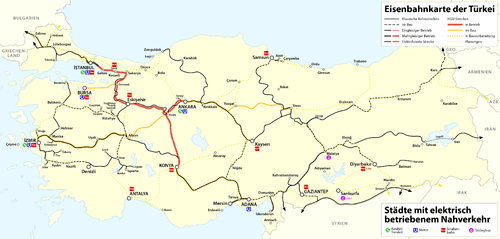Yüksek Hızlı Tren
 An eastbound YHT train in Ankara. | |||||||||||||||||||||||||||||||||||||||||||||||||||||||||||||||||||||||||||||||||||||||||||||||||||||||||||||||||||||||||||||||||||||||||||||||||||||||||||||||||||||||||||||||||||||||||||||||||||||||||||||||||||||||||||||||||||||||||||||||||||||||||||||||||||||||||||||||||||||||||||||||||||||||||||||||||||||||||||||||||||||||||||||||||||||||||||||||||||||||||||||||||||||||||||||||||||||||||||||||||||||||||
| Overview | |||||||||||||||||||||||||||||||||||||||||||||||||||||||||||||||||||||||||||||||||||||||||||||||||||||||||||||||||||||||||||||||||||||||||||||||||||||||||||||||||||||||||||||||||||||||||||||||||||||||||||||||||||||||||||||||||||||||||||||||||||||||||||||||||||||||||||||||||||||||||||||||||||||||||||||||||||||||||||||||||||||||||||||||||||||||||||||||||||||||||||||||||||||||||||||||||||||||||||||||||||||||||
|---|---|---|---|---|---|---|---|---|---|---|---|---|---|---|---|---|---|---|---|---|---|---|---|---|---|---|---|---|---|---|---|---|---|---|---|---|---|---|---|---|---|---|---|---|---|---|---|---|---|---|---|---|---|---|---|---|---|---|---|---|---|---|---|---|---|---|---|---|---|---|---|---|---|---|---|---|---|---|---|---|---|---|---|---|---|---|---|---|---|---|---|---|---|---|---|---|---|---|---|---|---|---|---|---|---|---|---|---|---|---|---|---|---|---|---|---|---|---|---|---|---|---|---|---|---|---|---|---|---|---|---|---|---|---|---|---|---|---|---|---|---|---|---|---|---|---|---|---|---|---|---|---|---|---|---|---|---|---|---|---|---|---|---|---|---|---|---|---|---|---|---|---|---|---|---|---|---|---|---|---|---|---|---|---|---|---|---|---|---|---|---|---|---|---|---|---|---|---|---|---|---|---|---|---|---|---|---|---|---|---|---|---|---|---|---|---|---|---|---|---|---|---|---|---|---|---|---|---|---|---|---|---|---|---|---|---|---|---|---|---|---|---|---|---|---|---|---|---|---|---|---|---|---|---|---|---|---|---|---|---|---|---|---|---|---|---|---|---|---|---|---|---|---|---|---|---|---|---|---|---|---|---|---|---|---|---|---|---|---|---|---|---|---|---|---|---|---|---|---|---|---|---|---|---|---|---|---|---|---|---|---|---|---|---|---|---|---|---|---|---|---|---|---|---|---|---|---|---|---|---|---|---|---|---|---|---|---|---|---|---|---|---|---|---|---|---|---|---|---|---|---|---|---|---|---|---|---|---|---|---|---|---|---|---|---|---|---|---|---|---|---|---|---|---|---|---|---|---|---|---|---|---|---|---|---|---|---|---|---|---|---|---|---|---|---|---|---|---|---|---|---|---|---|---|---|---|---|---|---|
| Service type | High-speed rail | ||||||||||||||||||||||||||||||||||||||||||||||||||||||||||||||||||||||||||||||||||||||||||||||||||||||||||||||||||||||||||||||||||||||||||||||||||||||||||||||||||||||||||||||||||||||||||||||||||||||||||||||||||||||||||||||||||||||||||||||||||||||||||||||||||||||||||||||||||||||||||||||||||||||||||||||||||||||||||||||||||||||||||||||||||||||||||||||||||||||||||||||||||||||||||||||||||||||||||||||||||||||||
| Status | Operating | ||||||||||||||||||||||||||||||||||||||||||||||||||||||||||||||||||||||||||||||||||||||||||||||||||||||||||||||||||||||||||||||||||||||||||||||||||||||||||||||||||||||||||||||||||||||||||||||||||||||||||||||||||||||||||||||||||||||||||||||||||||||||||||||||||||||||||||||||||||||||||||||||||||||||||||||||||||||||||||||||||||||||||||||||||||||||||||||||||||||||||||||||||||||||||||||||||||||||||||||||||||||||
| Locale | Northwest, Central Anatolia | ||||||||||||||||||||||||||||||||||||||||||||||||||||||||||||||||||||||||||||||||||||||||||||||||||||||||||||||||||||||||||||||||||||||||||||||||||||||||||||||||||||||||||||||||||||||||||||||||||||||||||||||||||||||||||||||||||||||||||||||||||||||||||||||||||||||||||||||||||||||||||||||||||||||||||||||||||||||||||||||||||||||||||||||||||||||||||||||||||||||||||||||||||||||||||||||||||||||||||||||||||||||||
| Predecessor |
| ||||||||||||||||||||||||||||||||||||||||||||||||||||||||||||||||||||||||||||||||||||||||||||||||||||||||||||||||||||||||||||||||||||||||||||||||||||||||||||||||||||||||||||||||||||||||||||||||||||||||||||||||||||||||||||||||||||||||||||||||||||||||||||||||||||||||||||||||||||||||||||||||||||||||||||||||||||||||||||||||||||||||||||||||||||||||||||||||||||||||||||||||||||||||||||||||||||||||||||||||||||||||
| First service | 13 March 2009 | ||||||||||||||||||||||||||||||||||||||||||||||||||||||||||||||||||||||||||||||||||||||||||||||||||||||||||||||||||||||||||||||||||||||||||||||||||||||||||||||||||||||||||||||||||||||||||||||||||||||||||||||||||||||||||||||||||||||||||||||||||||||||||||||||||||||||||||||||||||||||||||||||||||||||||||||||||||||||||||||||||||||||||||||||||||||||||||||||||||||||||||||||||||||||||||||||||||||||||||||||||||||||
| Current operator(s) | TCDD Taşımacılık | ||||||||||||||||||||||||||||||||||||||||||||||||||||||||||||||||||||||||||||||||||||||||||||||||||||||||||||||||||||||||||||||||||||||||||||||||||||||||||||||||||||||||||||||||||||||||||||||||||||||||||||||||||||||||||||||||||||||||||||||||||||||||||||||||||||||||||||||||||||||||||||||||||||||||||||||||||||||||||||||||||||||||||||||||||||||||||||||||||||||||||||||||||||||||||||||||||||||||||||||||||||||||
| Former operator(s) | Turkish State Railways | ||||||||||||||||||||||||||||||||||||||||||||||||||||||||||||||||||||||||||||||||||||||||||||||||||||||||||||||||||||||||||||||||||||||||||||||||||||||||||||||||||||||||||||||||||||||||||||||||||||||||||||||||||||||||||||||||||||||||||||||||||||||||||||||||||||||||||||||||||||||||||||||||||||||||||||||||||||||||||||||||||||||||||||||||||||||||||||||||||||||||||||||||||||||||||||||||||||||||||||||||||||||||
| Ridership | 5,898,387 (2016) | ||||||||||||||||||||||||||||||||||||||||||||||||||||||||||||||||||||||||||||||||||||||||||||||||||||||||||||||||||||||||||||||||||||||||||||||||||||||||||||||||||||||||||||||||||||||||||||||||||||||||||||||||||||||||||||||||||||||||||||||||||||||||||||||||||||||||||||||||||||||||||||||||||||||||||||||||||||||||||||||||||||||||||||||||||||||||||||||||||||||||||||||||||||||||||||||||||||||||||||||||||||||||
| Route | |||||||||||||||||||||||||||||||||||||||||||||||||||||||||||||||||||||||||||||||||||||||||||||||||||||||||||||||||||||||||||||||||||||||||||||||||||||||||||||||||||||||||||||||||||||||||||||||||||||||||||||||||||||||||||||||||||||||||||||||||||||||||||||||||||||||||||||||||||||||||||||||||||||||||||||||||||||||||||||||||||||||||||||||||||||||||||||||||||||||||||||||||||||||||||||||||||||||||||||||||||||||||
| Start | Ankara | ||||||||||||||||||||||||||||||||||||||||||||||||||||||||||||||||||||||||||||||||||||||||||||||||||||||||||||||||||||||||||||||||||||||||||||||||||||||||||||||||||||||||||||||||||||||||||||||||||||||||||||||||||||||||||||||||||||||||||||||||||||||||||||||||||||||||||||||||||||||||||||||||||||||||||||||||||||||||||||||||||||||||||||||||||||||||||||||||||||||||||||||||||||||||||||||||||||||||||||||||||||||||
| End | Istanbul or Konya | ||||||||||||||||||||||||||||||||||||||||||||||||||||||||||||||||||||||||||||||||||||||||||||||||||||||||||||||||||||||||||||||||||||||||||||||||||||||||||||||||||||||||||||||||||||||||||||||||||||||||||||||||||||||||||||||||||||||||||||||||||||||||||||||||||||||||||||||||||||||||||||||||||||||||||||||||||||||||||||||||||||||||||||||||||||||||||||||||||||||||||||||||||||||||||||||||||||||||||||||||||||||||
| Distance travelled | 245 km (152.2 mi) | ||||||||||||||||||||||||||||||||||||||||||||||||||||||||||||||||||||||||||||||||||||||||||||||||||||||||||||||||||||||||||||||||||||||||||||||||||||||||||||||||||||||||||||||||||||||||||||||||||||||||||||||||||||||||||||||||||||||||||||||||||||||||||||||||||||||||||||||||||||||||||||||||||||||||||||||||||||||||||||||||||||||||||||||||||||||||||||||||||||||||||||||||||||||||||||||||||||||||||||||||||||||||
| Average journey time | 1 hour, 50 minutes[1] | ||||||||||||||||||||||||||||||||||||||||||||||||||||||||||||||||||||||||||||||||||||||||||||||||||||||||||||||||||||||||||||||||||||||||||||||||||||||||||||||||||||||||||||||||||||||||||||||||||||||||||||||||||||||||||||||||||||||||||||||||||||||||||||||||||||||||||||||||||||||||||||||||||||||||||||||||||||||||||||||||||||||||||||||||||||||||||||||||||||||||||||||||||||||||||||||||||||||||||||||||||||||||
| Service frequency |
5 daily (Ankara-Eskişehir) 8 daily (Ankara-Istanbul) 10 daily (Ankara-Konya) 3 daily (Istanbul-Konya) | ||||||||||||||||||||||||||||||||||||||||||||||||||||||||||||||||||||||||||||||||||||||||||||||||||||||||||||||||||||||||||||||||||||||||||||||||||||||||||||||||||||||||||||||||||||||||||||||||||||||||||||||||||||||||||||||||||||||||||||||||||||||||||||||||||||||||||||||||||||||||||||||||||||||||||||||||||||||||||||||||||||||||||||||||||||||||||||||||||||||||||||||||||||||||||||||||||||||||||||||||||||||||
| On-board services | |||||||||||||||||||||||||||||||||||||||||||||||||||||||||||||||||||||||||||||||||||||||||||||||||||||||||||||||||||||||||||||||||||||||||||||||||||||||||||||||||||||||||||||||||||||||||||||||||||||||||||||||||||||||||||||||||||||||||||||||||||||||||||||||||||||||||||||||||||||||||||||||||||||||||||||||||||||||||||||||||||||||||||||||||||||||||||||||||||||||||||||||||||||||||||||||||||||||||||||||||||||||||
| Class(es) | First, business and economy class | ||||||||||||||||||||||||||||||||||||||||||||||||||||||||||||||||||||||||||||||||||||||||||||||||||||||||||||||||||||||||||||||||||||||||||||||||||||||||||||||||||||||||||||||||||||||||||||||||||||||||||||||||||||||||||||||||||||||||||||||||||||||||||||||||||||||||||||||||||||||||||||||||||||||||||||||||||||||||||||||||||||||||||||||||||||||||||||||||||||||||||||||||||||||||||||||||||||||||||||||||||||||||
| Disabled access | Fully accessible | ||||||||||||||||||||||||||||||||||||||||||||||||||||||||||||||||||||||||||||||||||||||||||||||||||||||||||||||||||||||||||||||||||||||||||||||||||||||||||||||||||||||||||||||||||||||||||||||||||||||||||||||||||||||||||||||||||||||||||||||||||||||||||||||||||||||||||||||||||||||||||||||||||||||||||||||||||||||||||||||||||||||||||||||||||||||||||||||||||||||||||||||||||||||||||||||||||||||||||||||||||||||||
| Catering facilities | On-board café, and at-seat meals (depending on the route) | ||||||||||||||||||||||||||||||||||||||||||||||||||||||||||||||||||||||||||||||||||||||||||||||||||||||||||||||||||||||||||||||||||||||||||||||||||||||||||||||||||||||||||||||||||||||||||||||||||||||||||||||||||||||||||||||||||||||||||||||||||||||||||||||||||||||||||||||||||||||||||||||||||||||||||||||||||||||||||||||||||||||||||||||||||||||||||||||||||||||||||||||||||||||||||||||||||||||||||||||||||||||||
| Entertainment facilities | On-board television with feature films | ||||||||||||||||||||||||||||||||||||||||||||||||||||||||||||||||||||||||||||||||||||||||||||||||||||||||||||||||||||||||||||||||||||||||||||||||||||||||||||||||||||||||||||||||||||||||||||||||||||||||||||||||||||||||||||||||||||||||||||||||||||||||||||||||||||||||||||||||||||||||||||||||||||||||||||||||||||||||||||||||||||||||||||||||||||||||||||||||||||||||||||||||||||||||||||||||||||||||||||||||||||||||
| Baggage facilities | Checked baggage available at selected stations | ||||||||||||||||||||||||||||||||||||||||||||||||||||||||||||||||||||||||||||||||||||||||||||||||||||||||||||||||||||||||||||||||||||||||||||||||||||||||||||||||||||||||||||||||||||||||||||||||||||||||||||||||||||||||||||||||||||||||||||||||||||||||||||||||||||||||||||||||||||||||||||||||||||||||||||||||||||||||||||||||||||||||||||||||||||||||||||||||||||||||||||||||||||||||||||||||||||||||||||||||||||||||
| Technical | |||||||||||||||||||||||||||||||||||||||||||||||||||||||||||||||||||||||||||||||||||||||||||||||||||||||||||||||||||||||||||||||||||||||||||||||||||||||||||||||||||||||||||||||||||||||||||||||||||||||||||||||||||||||||||||||||||||||||||||||||||||||||||||||||||||||||||||||||||||||||||||||||||||||||||||||||||||||||||||||||||||||||||||||||||||||||||||||||||||||||||||||||||||||||||||||||||||||||||||||||||||||||
| Rolling stock | HT65000 and HT80000 | ||||||||||||||||||||||||||||||||||||||||||||||||||||||||||||||||||||||||||||||||||||||||||||||||||||||||||||||||||||||||||||||||||||||||||||||||||||||||||||||||||||||||||||||||||||||||||||||||||||||||||||||||||||||||||||||||||||||||||||||||||||||||||||||||||||||||||||||||||||||||||||||||||||||||||||||||||||||||||||||||||||||||||||||||||||||||||||||||||||||||||||||||||||||||||||||||||||||||||||||||||||||||
| Track gauge | 1,435 mm (4 ft 8 1⁄2 in) standard gauge | ||||||||||||||||||||||||||||||||||||||||||||||||||||||||||||||||||||||||||||||||||||||||||||||||||||||||||||||||||||||||||||||||||||||||||||||||||||||||||||||||||||||||||||||||||||||||||||||||||||||||||||||||||||||||||||||||||||||||||||||||||||||||||||||||||||||||||||||||||||||||||||||||||||||||||||||||||||||||||||||||||||||||||||||||||||||||||||||||||||||||||||||||||||||||||||||||||||||||||||||||||||||||
| Electrification | 25 kV 50 Hz AC | ||||||||||||||||||||||||||||||||||||||||||||||||||||||||||||||||||||||||||||||||||||||||||||||||||||||||||||||||||||||||||||||||||||||||||||||||||||||||||||||||||||||||||||||||||||||||||||||||||||||||||||||||||||||||||||||||||||||||||||||||||||||||||||||||||||||||||||||||||||||||||||||||||||||||||||||||||||||||||||||||||||||||||||||||||||||||||||||||||||||||||||||||||||||||||||||||||||||||||||||||||||||||
| Operating speed | 250 km/h (155 mph) maximum[2] | ||||||||||||||||||||||||||||||||||||||||||||||||||||||||||||||||||||||||||||||||||||||||||||||||||||||||||||||||||||||||||||||||||||||||||||||||||||||||||||||||||||||||||||||||||||||||||||||||||||||||||||||||||||||||||||||||||||||||||||||||||||||||||||||||||||||||||||||||||||||||||||||||||||||||||||||||||||||||||||||||||||||||||||||||||||||||||||||||||||||||||||||||||||||||||||||||||||||||||||||||||||||||
| Track owner(s) | Turkish State Railways | ||||||||||||||||||||||||||||||||||||||||||||||||||||||||||||||||||||||||||||||||||||||||||||||||||||||||||||||||||||||||||||||||||||||||||||||||||||||||||||||||||||||||||||||||||||||||||||||||||||||||||||||||||||||||||||||||||||||||||||||||||||||||||||||||||||||||||||||||||||||||||||||||||||||||||||||||||||||||||||||||||||||||||||||||||||||||||||||||||||||||||||||||||||||||||||||||||||||||||||||||||||||||
| |||||||||||||||||||||||||||||||||||||||||||||||||||||||||||||||||||||||||||||||||||||||||||||||||||||||||||||||||||||||||||||||||||||||||||||||||||||||||||||||||||||||||||||||||||||||||||||||||||||||||||||||||||||||||||||||||||||||||||||||||||||||||||||||||||||||||||||||||||||||||||||||||||||||||||||||||||||||||||||||||||||||||||||||||||||||||||||||||||||||||||||||||||||||||||||||||||||||||||||||||||||||||
Yüksek Hızlı Tren or YHT (English: High-Speed Train) is the high-speed rail service of the Turkish State Railways, currently operating on two lines: Ankara to Istanbul via Eskişehir and Ankara to Konya via Polatlı. YHT is the only high-speed rail service in Turkey, with trains operating at speeds of up to 250 km/h (HT65000)[3] or 300 km/h (HT80000).[2]
History
Origins
Istanbul and Ankara are Turkey's largest two cities, having a combined population over 16,500,000. Transportation between the two cities is high. The Otoyol 4 motorway is a major highway between the two cities, and the Ankara–Istanbul route is the busiest route for the Turkish Airlines. The route between Istanbul and Ankara by rail has been a single-track line, and trains usually were delayed 30 minutes to 2 hours plus the average 7 hours, 30 minutes travel time. Rail transport in Turkey was already at its lowest point, so in 2003 the State Railways and the Turkish Ministry of Transport made an agreement to build a 533 km (331 mi) line between the two cities. The line would be an electrified double trackline. Construction began in 2004 from Esenkent to Eskişehir. The line was completed on April 23, 2007.[4]
Testing

On February 28, 2007, TCDD requested bids for high-speed train sets from other networks to be tested on the completed portion of the high-speed line.
On March 30, 2007, TCDD signed an agreement with Trenitalia of Ferrovie dello Stato to rent an ETR 500 train set for 4 months.[4][5]
The first run was from Haydarpaşa Terminal in Istanbul to the Central Station in Ankara, using the completed portion of the high-speed line between Hasanbey and Esenkent.
On September 14, 2007, the ETR 500 Y2 set a speed record in Turkey, reaching 303 km/h (188.3 mph).[6] This test received extensive media coverage in Turkey.
On November 20, 2007, the first TCDD HT65000 high-speed train sets purchased from CAF of Spain entered Turkey from the Kapıkule border station in Edirne,[7] and tests were subsequently made with these trains prior to the commencement of services on March 13, 2009.
Naming
TCDD requested bids for the name of the high-speed service. Out of over 100 entries, the ones with the highest votes were: Türk Yıldızı (Turkish Star), Turkuaz (Turquoise), Yüksek Hızlı Tren (High Speed Train), Çelik Kanat (Steel Wing) and Yıldırım (Lightning). TCDD chose Yüksek Hızlı Tren to be the name of the service.[8]
In 2010 one of the YHT trains was converted into a test train in order to test and measure the new lines.[9] The Transportation Ministry spent 14 million TL (around 7 million Euros at that time) for the installation of testing and measuring equipment on the train, which it named – because it is a tradition to give a name to test trains – as "Piri Reis" after the renowned Turkish admiral and cartographer who drew some of the most accurate and detailed maps of the Mediterranean Sea and the Americas in the early 16th century.[9]
Opening
On March 13, 2009, the inaugural ceremony took place in Ankara; attended by President Abdullah Gül, Prime Minister Recep Tayyip Erdoğan, and Minister of Transport Binali Yıldırım, who started the first phase of the YHT service between Ankara and Eskişehir.
Routes in service

YHT operates four routes using two different high-speed railways: the Ankara–Istanbul high-speed railway and the Polatlı–Konya high-speed railway.
Ankara-Eskişehir
Ankara to Eskişehir service was the first YHT and high-speed rail route in Turkey, entering service on 13 March 2009. The route has the most frequent train service of the whole YHT network, with 13 daily trains in each direction, 8 of which continue to Istanbul, while only 5 daily trains operate just between the two cities. The average journey time is 1 hour and 29 minutes.
Ankara-Istanbul
Before the YHT came into operation, average journey time between İstanbul and Ankara was 7 hours and 30 minutes. By transferring from the YHT to intercity trains at Eskişehir, average journey time between İstanbul and Ankara has fallen to 5 hours and 30 minutes.[10] After the completion of the second phase of the Ankara-Istanbul high-speed railway (Eskişehir-Istanbul) in 2013, some journeys between Ankara and Eskişehir were extended to Istanbul and YHT started running on the Ankara-Istanbul(Pendik) route on 26 July 2014. The journey is now reduced to as little as 3 hours 49 minutes.[1]
Ankara-Konya
The route was put into service on 23 August 2011 on the second high-speed railway line being constructed in Turkey. With its inauguration, the journey time between these two cities hugely decreased (mainly because of the absence of direct railway link between the cities).
Istanbul-Konya
The line was put into service on 17 December 2014. It stops at every stations on its route in which YHT service in present. The average journey time is about 4 hours and 17 minutes.
Future service
Turkey's high-speed rail network is expanding, with three more high-speed railways under construction and several more planned. The Turkish State Railways plans to increase its network of high-speed rail to 3,500 km (2,200 mi) by 2023.
Ankara-Sivas
Ankara to Sivas high-speed rail service is expected to begin towards the beginning of 2019. The 467 km (290 mi) route will reduce travel time between the two cities from 9 hours and 30 minutes to 2 hours and 50 minutes. The railway will use a straighter route to Sivas, through Yozgat, bypassing Kayseri. Direct service from Istanbul to Sivas is also planned upon opening with an expected journey time of around 5 hours.
Ankara-Afyon-İzmir
Ankara to İzmir high-speed rail service has been talked about since construction of the Ankara-Istanbul high-speed railway began. The 570 km (350 mi) long route will reduce travel time between the two cities from around 13 hours to 3 hours and 30 minutes. The route will diverge off the Polatlı-Konya high-speed railway just south of Polatlı junction and head west, through Afyonkarahisar. The railway will connect to the İzmir-Afyon railway at Manisa and continue into İzmir together with other trains. A second route into İzmir though Kemalpaşa is also planned. This route would diverge off the railway west of Turgutlu and enter İzmir from the east.The line would run underground, parallel with the Halkapınar—Otogar Line of the İzmir Metro, connecting to the existing railway at Halkapınar in the city center.
Service and Operation
Speed limitations

The YHT operates at a maximum speed of 300 km/h (186 mph)[2] on high-speed tracks. But the YHT also runs on non-high-speed and renewed tracks like the Köseköy-Gebze section of the Ankara–Istanbul high-speed railway where its top speed is 160 km/h (99 mph). Naturally, some speed restrictions also apply in urban sections while accessing the central station, especially in Ankara and Istanbul thus increasing the journey times. The speed on these sections is expected to increase when renewal projects in urban areas (like Başkentray and second phase of Marmaray) will be completed.
Passenger car specifications
The YHT uses the HT65000 EMUs built by CAF[3] and Siemens Velaro TR EMUs built by Siemens.[2] Every sets have railroad cars with cabins in the front and rear car, cars for economy class passengers and car(s) for first class passengers. Additionally, some HT80000 sets have business class cabins with 4 seats. The seating arrangements are 3 seats in a row (1 on one side, 2 on the other side) in first class and 4 seats in a row (2 on each side) in economy class. Automatic sliding doors provide passage between cars. Baggage may be stowed in the overhead compartments above the seats, or underneath the seats. Wi-Fi service is available with power inputs for laptops in first and business classes and all sets are wheelchair-accessible (with places in economy class only). In economy class, seats are fabric-coated and have audio connectors and foldable tables. In first class, there are leather-coated seats and a visual and audio broadcasting system that can broadcast at least 4 hours on 4 different channels.
Staff, operation and security
On YHT service, there is usually 1 train engineer (2 on some trains), a train manager (absent in some trips), two train attendants and a café car attendant. Business-class passengers are served meals at their seats if they applied for while buying their tickets. When accessing the trains, passengers must pass a security check like in airports. Maintenance of the sets is done at the Eryaman Yard in Ankara.
See also
External links
- TCDD Official Site (In Turkish)
- TCDD English Site
References
- 1 2 YHT Tanıtım Kitabi (YHT Reference Book), published by TCDD and Turkish Ministry of Transport.
- 1 2 3 4 5 "Velaro Turkey High-Speed Train" (PDF). Mobility.siemens.com. Retrieved 2015-06-20.
- 1 2 "Technical specifications of TCDD HT65000". CAF. Retrieved 15 July 2016.
- 1 2 "Demiryolu" Magazine March–April Issue
- ↑ Hürriyet: Hızlı tren artık raylarda
- ↑ "Nuovo record di velocità del treno italiano Etr 500 in Turchia: 303 km/h" (in Italian). Il Sole 24 Ore. 2007-09-14. Retrieved 2012-11-11.
- ↑ TCDD English Site - First High Speed Train set arrived in Turkey
- ↑ Vikipedi - YHT Vikipedi Page (in Turkish).
- 1 2 "Ankara-İstanbul YHT'yi Piri Reis ölçüyor". Hürriyet. 8 December 2013. Retrieved 15 July 2016.
- ↑ YHT Timetables TCDD Official Site